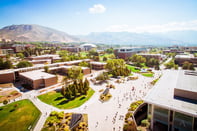Published on
Closing the Skills Gap and Meeting Industry Demands in Higher Ed

Higher ed institutions are uniquely positioned to serve both industry and learners by providing the skills both groups need to be sustainable—industry in the marketplace and learners in the workforce.
Employees—both current and future—are looking for ways to stay relevant and competitive in the workforce, which puts pressure on institutions to ensure they’re delivering the skills industry demands, while meeting learner needs. There continues to be a growing skills gap, and higher ed has an opportunity to help solve this issue. In this interview, Brenda Hellyer discusses the skills gap in higher ed, what’s expected of an institution and the economic development happening in Texas.
The EvoLLLution (Evo): How have you seen the skills gap evolve or persist in recent years?
Brenda Hellyer (BH): First, we have to define what the skills gap is. As you look across industry sectors, there’s a significant need for middle-skill workers—people who have less than a bachelor’s degree but more than a high school diploma. That’s what we keep hearing about around the skills gap. These are not uneducated people, but they typically need some kind of technical skill or hands-on training.
Maybe the gap is starting to grow because there is job growth, which makes it seem like there is a growing gap. Different areas of the country are starting to attract new employers and different companies, which causes overlap with other industries and a new level of competition. Additionally, jobs in many, if not most, industries are changing, requiring different skills. It could also be baby boomers are starting to retire. We’ve been hearing about this retirement piece for years, and maybe it is starting to hit us.
Our industry partners are looking for answers on how they can fill this need. There’s been progress, and we can see that in the industries we serve. For example, petrochemical is making progress that’s addressing the skills gaps, but the needs are continuing.
Evo: What do employers and learners expect of an institution?
BH: Employers want an institution that can help meet gaps they have in their workforce. They want people who are trained and skilled—and who have the skill sets to help reduce training after hiring.
They want workers that have a focus on that industry’s culture, especially when it comes to safety. So, employers expect community trainers like us to put those skills into the curriculum, so it’s not a surprise for new employees when they get into the workforce. We hear a lot about soft skills—we like to say they’re essential skills—like teamwork, time management and communication expectations.
Learners want to know the curriculum they’re taking will be relevant once they’re employed. They want a current credential that can help them gain employment. They need the hands-on component, but they also need to understand the technology pieces. So, they expect us to keep pace with our training and what we’re leading them to complete. They also want help connecting to employers. Many students do internships or apprenticeships, which is part of the hands-on training required.
Evo: What are some common challenges that higher ed leaders run into when they’re trying to prepare these learners for the workforce and meet their expectations?
BH: A challenge is understanding employer needs. We need to have a relationship where the employer gives us feedback on what’s working and what’s not working. We tell our partners that we want the good, the bad and the ugly. If we’re behind on curriculum updates the employer requires, we haven’t met their needs.
The other thing is ensuring we have enough funding for lab or technical and teaching spaces. We’ve been very lucky here at San Jacinto College. We’ve had strong bond programs that individuals as well as business and industry want in our community. It can be challenging, but having the resources to house expected facilities, the needed equipment and current programs and technology are necessary for student success in the workforce.
Along with that, getting qualified faculty can be another challenge. We want to make sure faculty, including our part-time faculty in these technical programs, have professional development built in, so they’re up to date with what’s happening in the market. We need both full-time and part-time qualified faculty.
The other challenge is helping students see the opportunities in middle-skill jobs in these industries. Helping learners and their families really see the job opportunities and how they tie into their life—including social and economic mobility—is very important.
Evo: What are some best practices to overcome these common obstacles in order to begin meeting workforce and learner needs?
BH: First and foremost, you need partnerships with your businesses and your industries—relationships where you’re really honest with each other. As an institution, you have to truly listen to your industry partners and figure out solutions together.
We use advisory councils consisting of C-suite people and senior industry experts. We talk strategy. We discuss the challenges occurring and how to approach them strategically. That strategy conversation is very important. We also have advisory committees that are more faculty-based, and we’re able to figure out which employers need to be a part of the conversation. Being able to partner together and bring that level of collaboration to recruitment outreach is critical.
Evo: What kind of impact does meeting workforce and learner needs have, not only on the institution, but also the community?
BH: Meeting workforce and learner needs really changes the social and economic vitality of your community. You’re helping prepare future employees for the businesses in your community, and that drives wages.
It also attracts new businesses. Part of the work San Jacinto College does is being at the table with our economic development partners as new industries and new industry sectors look at this region, and we’re an important partner to have at the table. It helps fill that pipeline and attract additional businesses. The bottom line is it’s about building strong families and civic engagement, which has a ripple effect throughout your entire community.
Evo: What are some opportunities ahead for higher ed when it comes to economic development in Texas?
BH: This past legislative session was a big one for community colleges in Texas. We went to an entirely new funding model based on outcomes, so it’s a performance-funding model. It’s pretty unusual for higher ed, especially in Texas. The whole sector of community colleges was unanimous that this is the right approach to take. There was strong support among legislators. I think it will help change delivery and the ability to meet workforce needs because it puts a lot more focus on workforce, especially in high-demand areas. Additionally, it puts focus on transfer and dual credit.
There’s also a lot of innovation within the state, for example with competency-based education (CBE). Those with real-life experience can find out the competencies they have or are lacking and fill in the gaps to go back into the workforce or move up at their current company. CBE is definitely an area we’ll see grow.
Also, there’s a new program in Texas that will be piloted in the fall, and it’s called Opportunity High School. It’s looking at the population without a high school diploma and how community colleges can help them earn a credential.
Over the last year, we’ve had about 2.5% job growth in the state of Texas compared to about 2.1% in the United States %. So being innovative like this and looking at what’s needed to train the workforce is only going to help maintain and capitalize on that competitiveness. That’s what we need to do to continue sustaining our economy and really compete.
Evo: Is there anything you’d like to add?
BH: At San Jacinto College, we have our Promise @ San Jac program, which started with a donation from Mackenzie Scott. The program itself is a promise to the community. For every high school senior in our taxing district (over 7,000 a year), it shows them that an education at San Jacinto College can be obtained debt-free at no cost.
We’re working to create an endowment for that and have reached about 80% of our goal right now. We leverage federal and state financial aid, then make up the difference with our Promise program, so students know that they can earn a credential. This scholarship is available to every graduating senior in our taxing district with no GPA or financial requirements.
Now, it’s a promise because we’re ensuring the resources are there but they’re promising to perform. So, the student has to attend full-time—twelve hours a week or more—needs to maintain a 2.0 GPA and finish within three years. This program opens up opportunities to many pathways, whether it’s the workforce or a degree program for academic transfer.
This program is really focused on our community’s social and economic mobility. Our last cohort in fall 2023 had over 3,000 students, 78% of whom were first-generation college students. We need innovative programs like that—programs that really let the community know we’re here for it and we’re going to do it together.


